

Electric vehicles are supposed to be green, but the truth is a bit murkier. At gatherings of electric vehicle enthusiasts, the curious surround Rob Spritzer and his car.
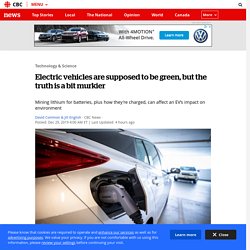
Both are celebrities in these circles — he's known as "High Mileage Rob," having driven more than 115,000 kilometres in his Tesla Model 3 in a little more than a year of ownership. No other Model 3 in Canada is believed to have reached that milestone in such a short time, and it's possible no other battery-only electric vehicle has either. And not once has he stopped for gas. Never changed the oil. "I probably saved about $10,000 last year," Spritzer says. He's also trying to save the planet by eliminating greenhouse gas emissions. But that doesn't mean there isn't a carbon footprint. An electric car doesn't produce emissions, but its parts still have a carbon footprint. This Forestry Town Will Be Canada's First Geothermal Village A forestry town is working to re-invent itself as a renewable energy leader with a project that promises community revitalization from the ground up.

The mountain village of Valemount, British Columbia, located along the Rocky Mountain trench is eyeing the nearby Canoe Reach hot springs -- one of the hottest surface hot springs in Canada -- as a source of geothermal heat and renewable electricity generation. There's more to energy independence than phasing out foreign oil. It’s time to update our definition of energy independence.

As the United States increasingly relies on domestic sources of energy, we need to recognize that the traditional formulation of independence falls short. A true calculation of our national energy freedom would include the way other nations produce their own power. I’ll explain. The other economic threat For decades, the specter of hostile nations controlling the energy that fuels our economy has been seen as a threat to our security, prosperity and diplomatic freedom. So it’s good news that the U.S. is increasingly in control of our own energy. Emissions have no borders Climate change is extremely expensive.
Indian 'Solar Tree' to Allow for Smaller Solar Parks. Greenbiz. Can we afford to teach our children?

In the U.S. we generally can agree that educating our children is important. Consensus stops there. Whether the U.S. education system is broken, and if so, how to best fix it, is an increasingly politicized debate. Current discussions on how to improve education have focused on better teachers, better technology and more funding (which deepens the debate on who should pay for it). But consider that each year K–12 schools spend more than $8 billion on energy — more than they spend on computers and textbooks combined. The majority of school facilities fail to meet even basic occupant needs, and fall short on meeting the evolving education demands for a 21st century economy. RMI and New Buildings Institute (NBI) believe schools are a prime market for neft-zero energy design and operation, in both new construction and deep energy retrofit projects of existing building. Why invest in net zero schools?
1. 2. 3. Net zero buildings are the future. Matt Price: Canadian Environmentalists Don't Have Time to Be Polite. There's an old joke that goes: How do you get 20 Canadians out of a swimming pool?

You shout, "Hey you Canadians, get out of the swimming pool. " We're generally an obedient lot, except while on skates, so what gives with the plan of a group of Canadians to block Warren Buffett's coal trains near Vancouver this Saturday? Most of us watched the Al Gore movie on climate change, told pollsters we were concerned about it, and then went back to business as usual. No more power lines? By Mark Clayton, Staff Writer for The Christian Science Monitor / December 31, 2009 Abundant solar and wind power lies across America’s vast plains and deserts, but getting that distant renewable energy to cities without wrecking vistas and raising lawsuits over transmission lines is a sizable hurdle for green-leaning utility companies.
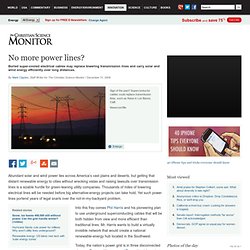
Thousands of miles of towering electrical lines will be needed before big alternative-energy projects can take hold. Talk Business to Me - Microsoft's Dirty Cloud. California garbage trucks fueled by ... garbage. Hundreds of trash trucks across California are rumbling down city streets using clean fuel made from a dirty source: garbage.
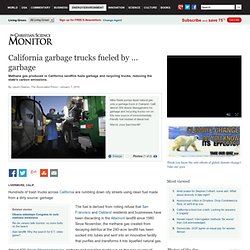
Wind power: Clean energy, dirty business? Like the oil drilling rig that became an icon of the Industrial Age, the giant, spinning wind turbine has become a global image of clean power.
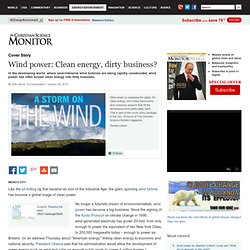
Skip to next paragraph Subscribe Today to the Monitor Click Here for your FREE 30 DAYS ofThe Christian Science MonitorWeekly Digital Edition. Dirty data: Apple has the least-green data centers, says Greenpeace. If the Internet were a country, it would be the fifth biggest consumer of electricity in the world, according to Greenpeace.

Skip to next paragraph Subscribe Today to the Monitor Click Here for your FREE 30 DAYS ofThe Christian Science MonitorWeekly Digital Edition. Google Rents Goats to Replace Lawnmowers and Fertilizer. The world can be powered by alternative energy, using todays technology, in 20-40 years, says Stanford researcher Mark Z. Jacobson. January 26, 2011 A new study – co-authored by Stanford researcher Mark Z.
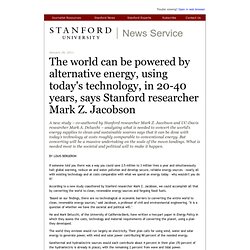
Jacobson and UC-Davis researcher Mark A.